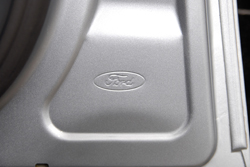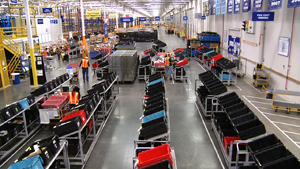Warehousing is a critical part of spare parts distribution, with carmakers having to balance decisions on locations, size, providers, IT systems and picking technology.

Every vehicle manufacturer knows the importance of aftermarket service. Dealers demand overnight - if not same day - delivery; a vehicle off the road means not only an unhappy dealer, but a consumer who might well choose a different manufacturer the next time they replace their vehicle.
To provide the necessary quality of aftermarket service, carmakers need to have a well-organised and managed warehouse with the right amount of inventory in the right place at all times – and it takes a tremendous amount of thought, analysis, planning and care to create and maintain the optimum facility. BMW served as a recent reminder of just how costly glitches in spare parts supply can be, when an error in its central warehouse in Germany made it necessary to fly parts across the world.
OEMs’ spare parts warehousing can vary in size and density depending on market penetration and vehicle type. Ford’s network in North America is an example of a highly complex network: it has a low volume, low cube warehouse near an air cargo hub to provide late order cut-off and improve order fill; three high-cube centres concentrating on larger parts; 19 high velocity centres near the dealers (what some would call regional distribution centres) storing high-volume parts; one national parts distribution centre and one parts replenishment centre which replenishes all the other facilities. In Europe, meanwhile, the carmaker currently has eight warehouses, including Russia.
You put your warehouse out, you take your warehouse in
One of the important decisions that an OEM must make about its warehouses is whether to outsource it or keep it in-house. Many manufacturers choose to outsource, as indicated by the number of third party logistics providers involved in the aftermarket warehousing sector, including Neovia, DHL, Logwin, Yusen Logistics, Gefco and Ceva, to name a few players. However, while some logistics companies are seeing an increase in their aftermarket business, there are also OEMs that have taken their warehousing back in-house.
One example of such ‘in-sourcing’ can be found at General Motors in North America. “There has been an evolution at GM,” comments Charlie Hyndman, executive director of global warehousing and distribution. “At one time, we wanted to outsource everything, but over the last five years, we decided to bring work back in-house.
“We believe – and we’ve proven, through our industry leadership in key performance metrics – that we can do it better ourselves,” he adds. “We have found that third party warehousing expertise is limited, and they don’t have enough experienced professionals so we end up showing them what to do.”
Volkswagen also brought its North American spare parts warehousing back in-house. “We offered a two or three day delivery service, but wanted to improve that to next day, which wasn’t possible with our outsourced system” explains Anu Goal, vice-president of parts and vehicle logistics for VW Group of America. “Our philosophy is around customer service and if you outsource you lose the focus on the customer and look only at the costs.”
 Ford has divided its approach to outsourcing in Europe, with half of its warehouses run by in-house staff, and the other half by third party providers
Ford has divided its approach to outsourcing in Europe, with half of its warehouses run by in-house staff, and the other half by third party providers
Goal adds, however, that the choice over whether or not to outsource depends on a company’s distribution priorities, motivation and a product’s lifecycle. In some cases, the investment in a warehouse just might be too high for a market or a product.
Aftermarket is generally a more profitable area for carmakers than passenger car sales, and so OEMs are often more protective of their operations, according to Michael Martin, DHL’s vice-president of business development for automotive. “There is more openness in sharing, collaborating and outsourcing with inbound warehousing than there is with aftermarket,” he says. “OEMs have strong opinions about outsourcing, too. If they believe in it, they approach the market with outsourcing in mind; if they want to keep it in-house, it’s hard to persuade them to change that approach.”
Ford and the middle ground
But there is a middle way. Ford in Europe, for example, runs a mixed warehousing model, keeping some core competencies and facilities in-house, but outsourcing others. It runs four of its eight warehouses in Europe with in-house – in Germany, the UK, Spain and France – while those in Italy, Sweden, Russia and Poland are outsourced.
“We want to keep our own expertise in logistics, transport and customs,” says Raymond Damerow, director of parts supply and logistics in Ford’s European customer service division. “We would never outsource completely, but when we need further facilities, we go to a 3PL. In addition, we expect our outsourced provider to use our operating principles and processes, our KPIs, and our systems. We keep management oversight of the 3PL, while not generally having our own staff in the 3PL’s warehouse.”

Using a third party can bring more flexibility in terms of obtaining more staff or capacity, according to Damerow. The use of a provider also offers opportunities for Ford Europe to benchmark its warehousing operations between its own staff and those of logistics companies. “We share things with our 3PLs, too,” adds Damerow. “Sometimes we have the best process for a particular activity and they learn from us, but as we use large, professional 3PLs with a lot of expertise and experience, they can bring excellence to all our warehouses, whether they are run by Ford or by any of our service providers.”
The benchmarking and sharing is extensive. All Ford warehouse managers, whether in-house or outsourced, get together twice a year to share best practices, while managers of smaller facilities meet up four times a year. A monthly review allows everyone to see what is going on in the organisation.
“These meetings add to a permanent process to improve and maintain quality,” Damerow emphasises. “We even hold competitions between warehouses. Last year we picked several metrics, such as ‘denials’, in which there is not enough stock on the shelf to fulfil a pick request, and compared performance results.”
There are other examples in which a 3PL might be be asked to run just one part of the warehousing operation, such as material for a new model or in a new market. “A lot of manufacturers are looking to expand in Asia,” points out Chris Senior, global key account director at Ceva Logistics. “They don’t always know the local market and are happy to have someone deal with that on their behalf. They may even be willing to share a warehouse; although most aftermarket facilities are dedicated to one OEM, there is more interest in shared resources to cut costs.”
Raymond Damerow, Ford Europe
Using a 3PL for peak periods or overflow warehousing is common. French automotive logistics provider Groupe Cat points out that a carmaker might have it take over a warehouse for one type of product, such as winter tires, according to Harry Doms, managing director of Groupe Cat in Benelux and the commercial cargo division. Other activities liable to be outsourced include inventory management, packing, or even loading vehicles, including scanning items as they are loaded to ensure the right goods are going to the right dealer.
What’s the right warehouse size?
OEMs almost exclusively decide on the location of their parts warehouses, and usually the size. The aim is to serve as many dealers as possible from one site. “Historically, parts distribution has needed some large central storage as some parts are stored for a long period of time,” says Stephan Freichel, formerly with Logwin Logistics and now a consultant and professor of distribution and logistics at Cologne’s University of Applied Sciences. “Cars have to be serviced for 10 or 15 years. So OEMs would go for one large central DC and then global regional warehouses and finally intra-regional DCs,” he says.
Some models are only sold in one region and require a dedicated warehouse for that model, according to Freichel. Intra-regional DCs are usually close to the OEM, but also need to be close enough to a manufacturer’s own dealers to offer the desired service levels by the most appropriate mode of transport, which is usually road.

“Smaller OEMs may need a fewer number of regional DCs, but then provide a longer service time or incur a high transport cost, by using air freight for example,” he adds.
Every OEM has to decide where and how big a warehouse should be, with sizes often ranging from 25,000-50,000 square metres – as well as below and above that. However, warehouses that are very large can generate too much ‘walk’ time, say experts. In any case, the 3PL can help in making these decisions.
“An OEM can say it wants a certain size facility in a certain location,” points out Michael Schmidt, vice-president of business development at Neovia. “It is our job to test that. They could ask for a 500,000 square feet (46,000 square metres) facility in the Cincinnati, Ohio area, but when we look at the type of warehouse – a regional parts DC or a satellite – the data, inventory levels and turn, customer expectation, where the product is going and so on, we might suggest they only need 300,000 square feet.”
General Motors has a two-tier distribution model globally, with 77 warehouses that are mostly identical in 31 countries. According to Hyndman, some are re-distribution centres in which parts arrive in bulk from the supplier and are re-distributed to parts distribution centres, while the rest serve the dealers. GM’s parts distribution centre warehouses are generally around 400,000 square feet. “We chose optimal locations to allow us to provide a next-day service to our customers,” says Hyndman. “We have our own packaging centre in Michigan and re-pack approximately 50% of the volume that comes in.”
Pick the right one
The service promise to the dealer is the main driver for not just the size and location of a warehouse, but the way in which goods are put away and packed. When VW Group of America wanted to switch from two-three day delivery to next day, it needed to change its way of picking to suit.
“We were picking by dealer, but we could not sustain that model and provide a next-day delivery,” explains Goal. “So we switched to batch picking, with the batch broken down on the dock into individual orders. We have now been able to reduce our order cut-off time, too, from 22.00 to 13.00. Orders made by 13.00 are delivered by 10.00 the next day, but 70% of them arrive before 7.00. And we’ve added a 17.00 cut-off for emergency orders. We can now reach 94% of our dealer network by 10.00 the next day, out of six aftermarket parts distribution centres and two regional DCs.”
According to Hyndman, GM focuses on velocity stocking and moves parts within its warehouses so that faster-moving items are closer to the dock. The carmaker’s warehouse management system (WMS) creates the optimal batch-picking route, ensuring a minimum amount of walk time.
 GM has 77 spare parts warehouses in 31 countries, which are built to nearly identical specifications. Above, a warehouse in Denver, Colorado
GM has 77 spare parts warehouses in 31 countries, which are built to nearly identical specifications. Above, a warehouse in Denver, ColoradoFord, which is also using its own system to SAP in Europe, runs its European supply chain management centrally, deciding what quantity of which parts should go into each warehouse. “We want one platform for aftersales,” says Damerow. “SAP’s service parts management system has three modules: inventory management, warehousing and commercial, which covers order taking, claims, accountancy, etc.”
Ford Europe currently relies on a wave picking system, in which the warehouse is split into three zones: high-moving stock, medium movers and slow movers. Separate zones exist for small, easy-to-pick parts and heavier, large items. Three types of picking systems are used: bulk, for full pallets; mass, in which stock for multiple dealers goes in one unit (such as from Daventry to London in the UK); and dealer, in which only goods for a particular dealer are picked.
Anu Goel, VW Group of America
DHL has also begun offering pick-by-registration, something many OEMs and 3PLs are considering. Everything needed to repair one vehicle is picked and delivered together, so the mechanic has all the parts needed for that repair. As Martin points out, a big dealer can have ten or more repair bays, so it is a huge help to have everything in one place.
“Pick by registration is an interesting concept,” agrees Goel at VW Group of America. However, he is sceptical that the industry is quite ready for it. “I don’t think systems can support it yet.”
Neovia is increasingly asked to pick and deliver by order; if it cannot pick every line required for one order, it does not consider it a ‘fill’. However, as Schmidt comments, no single storage or picking formula works for everybody. Each OEM and 3PL has to decide which type of operation is best for them, he says.
Warehouse management systems and automation
And the same sort of custom approach for operations also goes for warehouse management systems (WMS). “A WMS has to be practical,” Schmidt says. “One size does not fit all. A number of OEMs use SAP, but it is not always right for aftermarket. Each company has to do a value analysis and see when it will get ROI from its system.”

An OEM often expects 3PLs to use its own system, but integrating a 3PL’s system to the customer’s - and sometimes the carrier’s - isn’t always easy. “Technically it’s not hard,” says Hugo Van Herck, director of contract logistics at Yusen Logistics Benelux. “The biggest issue is interpretation of data and how it’s used by the customer. How do we make sure we have the right data? We have to understand how our customers work and how we can translate their data into a format we can use efficiently.”
While a WMS is normally considered essential to the successful running of a parts warehouse, not many companies have fully automated their facilities – and GM North America even took its automation out. “Automation in warehousing can be detrimental to running an efficient operation; it can add distance, is capital intensive, demands high maintenance and is subject to breakdown,” says Hyndman.
Automation can also lack flexibility. “Parts are not a standard shape,” Yusen’s Van Herck points out. “And they’re always changing, which makes it hard to automate. Some aftermarket warehouses may have conveyors to move things from one part of the site to another, but that’s it.”
“Parts warehouses don’t have the economy of scale to justify automation,” says John Stocker, sales and marketing director for Gefco in the UK. “Some OEMs have got burnt by investing in automation that couldn’t change with the business.”
Freichel agrees. “There are a lot of manual processes in parts warehousing because of the heterogeneity of the stock. For high-moving small parts, high bays and cranes or conveyors may be used, but this equipment doesn’t lend itself to most aftermarket parts. Some companies don’t even use bar codes – just manual pick lists.”
Voice picking seems to be the exception. Ford uses voice picking in Cologne, Germany and Valencia, Spain and is installing it in other warehouses because it improves the quality of picking and increases productivity. Such accuracy and productivity improvements are important tools in the fight to stay ahead of the game. OEMs are reducing inventory – but so are the dealers. “Stock levels are low,” affirms Groupe Cat’s Harry Doms.
Van Herck emphasises that as inventory reduces, warehouse operations need more agility and flexibility. “Once a part has been used at a dealer, it may automatically order another and want it delivered the same night,” he says.
Keeping up with the independents
OEMs’ efforts to take market share away from the independent parts suppliers are also driving improvements in warehousing. To capture some of the independent suppliers’ business, OEMs have increasingly been responding to dealers’ demands for same-day delivery of almost any part.
In the rush to increase customer service, some carmakers are opening local DCs with the aim of offering three or four deliveries per day. DHL and Neovia are two of the 3PLs running local DCs for customers. DHL has found surprising changes in the OEM’s approach to aftermarket storage. For a start, they are more willing to share and collaborate with competitors in a local distribution centre, probably because of the higher cost of providing multiple deliveries per day. While most OEMs that outsource prefer to keep transport and warehousing separate, when they open a local DC, it can make sense to use the same 3PL for both.
Stephen Freichal, University of Applied Sciences, Cologne
Increased competition and demand for higher quality service makes aftermarket parts warehousing and distribution more important than ever. “Parts logistics is completely different from inbound or vehicle logistics,” says Freichel. “Yet OEMs still try to run them both with the same logistics department. That’s a big mistake. There should always be warehousing capability in-house, too: an OEM should always be able to assess its warehouse operations and drive its own KPIs.”
In fact, aftermarket is such a major contributor to an OEM’s bottom line, some believe it’s time carmakers put logistics professionals with spare parts experience on their management boards. That may or may not start happening soon, but it’s clear that spare parts warehousing is an important competitive advantage for carmaker’s profitability and market share.

























![Global[1]](https://d3n5uof8vony13.cloudfront.net/Pictures/web/a/d/s/global1_726550.svgz)












